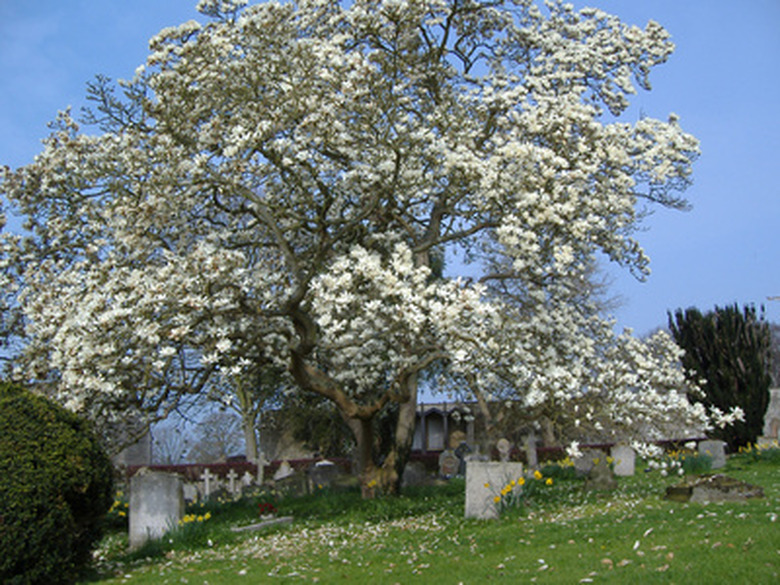Magnolia Trees Of Alabama
Magnolias, moonlight and Spanish moss–some images capture the spirit not only of a region but of an entire way of life. Magnolia trees have become icons of the America's deep South. Alabama is home to several varieties of this stately tree. Each of them, small or large, perfumes the spring air with its fragrant, showy blooms. Many provide deep shade in the heat of Alabama's summers.
Southern Magnolia
Southern magnolia (Magnolia grandiflora) is one of the most spectacular of America's blooming trees. With a straight trunk and pyramid-like crown, Southern magnolia stands between 50 and 100 feet tall. It has large (5-to-10-inch) leaves with deep green glossy surfaces and rust-colored undersides. During the summer and early fall, the ends of its branches are adorned with fragrant 6-petaled white flowers, up to 8 inches across.
- Magnolias, moonlight and Spanish moss–some images capture the spirit not only of a region but of an entire way of life.
- Southern magnolia (Magnolia grandiflora) is one of the most spectacular of America's blooming trees.
Flowers open in the morning and close at dusk, with each lasting from two to three days before dying. Showy cone-shaped reddish-brown seedpods follow the flowers, opening to suspend their red kidney-shaped seeds from silken threads. Dried leaves and cones are useful in floral arrangements.
Plant southern magnolia in part shade and dry, acidic sandy or loamy soil. Place trees where their shade won't affect other plants. Prune immediately after blooming. Dormant magnolias have difficulty recovering from pruning.
- Flowers open in the morning and close at dusk, with each lasting from two to three days before dying.
- Showy cone-shaped reddish-brown seedpods follow the flowers, opening to suspend their red kidney-shaped seeds from silken threads.
Sweetbay Magnolia
Sweetbay magnolia (Magnolia virginiana) grows wild in shaded woods and swamps from Florida as far north as Massachusetts. Only rarely does it reach 50 feet in warmer parts of the country. More typically, this tree stands between 12 and 20 feet, making it an excellent choice for small areas.
Sweetbay magnolia's multiple trunks have horizontal branches producing spicily scented twigs and leaves. Leaf color depends on location. Southern trees, which may be evergreen, have deep green foliage. Northern trees lose their bronze leaves in the fall.
- Sweetbay magnolia (Magnolia virginiana) grows wild in shaded woods and swamps from Florida as far north as Massachusetts.
- More typically, this tree stands between 12 and 20 feet, making it an excellent choice for small areas.
Each branch produces a single, fragrant, densely petaled white flower (4 to 6 inches long) followed by a deep red cone with visible red seeds. Like those of southern magnolias, says the Lady Bird Johnson Wildflower Center, sweetbay's blossoms live only two to three days. Disease-and-pest-resistant sweetbay tolerates any moist, rich acidic soil. Plant it in a partly shady spot and be patient. It's a slow grower, taking as long as five years to bloom.
Cucumbertree
Cucumbertree (Magnolia acuminata) may not be a common Alabama magnolia, but it survives as far north as Canada. Reaching up to 75 feet high, this excellent shade tree has dark green 6-to-10-inch leaves that become yellow in autumn. three-inch, yellow-green flowers appear high on cucumber tree in May and June. Both its buds and flowers are edible.
- Each branch produces a single, fragrant, densely petaled white flower (4 to 6 inches long) followed by a deep red cone with visible red seeds.
- Cucumbertree (Magnolia acuminata) may not be a common Alabama magnolia, but it survives as far north as Canada.
Bright red cucumber-shaped seed cones follow the flowers. Trees often drop their fruit with seeds intact, providing food for small mammals and birds. Plant cucumber magnolia in sun to shade where its falling leaves and fruit won't be a problem. It tolerates any moist, rich acidic soil, but won't survive pollution, prolonged drought or wet periods.
